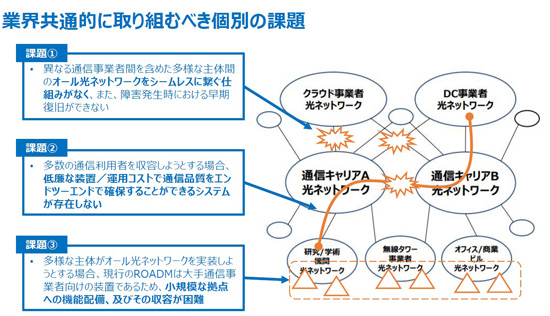NTT and five other companies make it possible to deploy APNs for data centers

NTT, KDDI, Rakuten Mobile, Fujitsu, and NEC have been selected as companies to carry out new commissioned research on the Social Implementation and Overseas Expansion-oriented Strategic Program (Establishment of Common Platform Technology) of the Innovative Information and Communications Technology (Beyond 5G (6G)) Fund Project, which was publicly solicited by the National Institute of Information and Communications Technology (NICT).
This research and development will ensure fault tolerance and service quality assurance through the cooperation of APNs (all-photonics networks) provided by multiple providers, and will also enable users to simultaneously use multiple clouds and data centers and flexibly switch between connection destinations. They will develop technology to achieve this.
They will also develop small APN nodes that will enable the deployment of APNs to regional data centers and small and medium-sized bases.
Specifically, they will develop three technologies: ①optical network federation technology, ② sub-channel circuit switching technology, and ③distributed ROADM technology.
①will be a mechanism for seamlessly connecting a variety of entities, including different telecommunications carriers, such as cloud providers and data center operators, via APN.
②is a technology that will enable the simultaneous use of multiple clouds and data centers and flexible switching. When attempting to accommodate a large number of communications users, it becomes increasingly necessary to have inexpensive equipment and low operating costs. For example, communication quality must be guaranteed end-to-end. Subchannel circuit switching technology satisfies these requirements.
With regard to ③ , when a variety of entities use the APN, it is necessary to consider the deployment of functions at small-scale bases and their accommodation. This makes it possible. ROADM is an optical signal switching point (optical node), and is a node device that can be remotely operated (reconfigurable) to add and drop any optical wavelength, as well as multiplex and recombine.
As an optical network federation technology, KDDI has developed an architecture and interface for optical network connections between businesses. NTT will design the interface for the two companies.
Rakuten Mobile will design the mobile sector architecture for optical network connections between businesses.
NEC will develop the automated design of optical networks and the automatic generation of operational scenarios using AI. Fujitsu will work on developing control technology for gateway equipment for optical network connections between carriers.
For sub-channel circuit switching technology, NTT will advance the development of communications control technology on a sub-channel basis.
For distributed ROADM technology, Fujitsu will develop multi-directional (network side) and small (user site side) ROADM, and NEC will also be responsible for developing small (user site side) ROADM.
NTT will consider the overall architecture.
※Translating Japanese articles into English with AI
